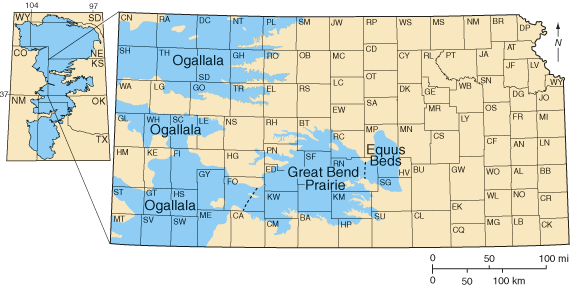Kansas Geological Survey, Public Information Circular (PIC) 22
Next Page--Factors Influencing Recharge
![]()
![]()
![]()
Kansas Geological Survey, Public Information Circular (PIC) 22
Next Page--Factors Influencing Recharge
Marios Sophocleous and Rex C. Buchanan
Recharge is generally defined as the movement of water from the land surface into an aquifer. Recharge can be either natural, from precipitation that falls on the earth's surface and works its way underground, or it can be artificial, from human activities that deliberately or inadvertently replenish an aquifer. Knowledge of recharge is necessary to effectively manage ground-water resources and protect them from pollution, and to determine how fast an aquifer will be depleted when pumping and natural outflow exceed recharge.
This public information circular describes the factors that influence recharge, research on recharge rates in Kansas, the consensus about recharge rates across the state, the importance of recharge in water management, and artificial-recharge projects in Kansas. Recharge is an especially important issue in western Kansas, where high-volume pumping from the Ogallala portion of the High Plains aquifer (fig. 1) and low recharge rates raise concerns about ground-water depletion. Therefore, much of this circular focuses on recharge and related issues in western Kansas, although the principles outlined here apply to all areas.
Figure 1--Extent of the High Plains aquifer in Kansas.

Recharge is the movement of water into an aquifer (a geologic formation that holds water in its pore space in economic quantities). While the primary source of natural recharge is precipitation, other sources of recharge to an aquifer are seepage from streams and lakes, or movement of water from one aquifer into another. Recharge also can be human induced; examples of artificial recharge include irrigation return-flow (water that moves from irrigated fields or canals back into an aquifer) and water from water mains, septic tanks, sewers, or drainage ditches. In general, however, artificial recharge refers to the deliberate use of water to replenish an aquifer.
Recharge is usually measured in inches of water per year, the same way that precipitation is measured. However, a given amount of recharge may result in a larger increase in the elevation of a water table. For example, one inch of recharge might increase the water level in an aquifer by five or six inches. That is because only about 10 to 25 percent of an aquifer is pore space that is connected; the rest is the solid material, such as sand and gravel, that makes up the aquifer. In an aquifer that consists of 17 percent interconnected pore space, the movement of 1 foot of water into the aquifer would result in a water-level increase of about 6 feet.
Next Page--Factors Influencing Recharge
Kansas Geological Survey, Public Outreach
Web version August 15, 2003
http://www.kgs.ku.edu/Publications/pic22/pic22_1.html